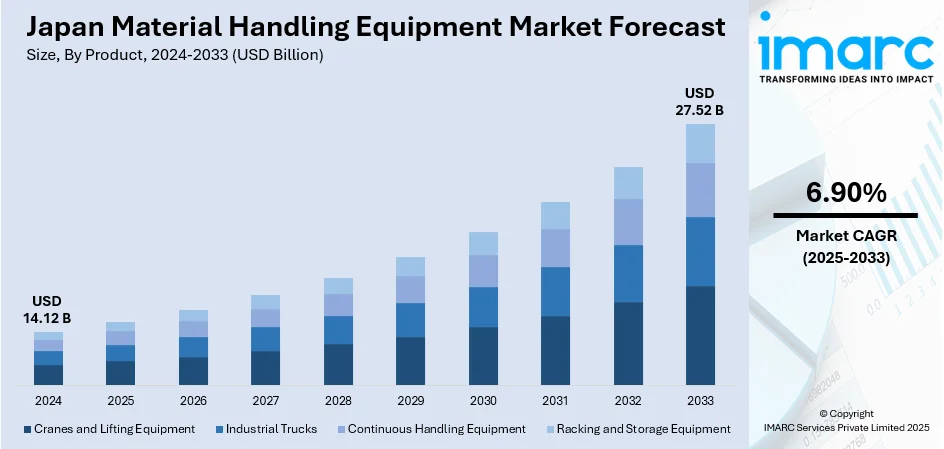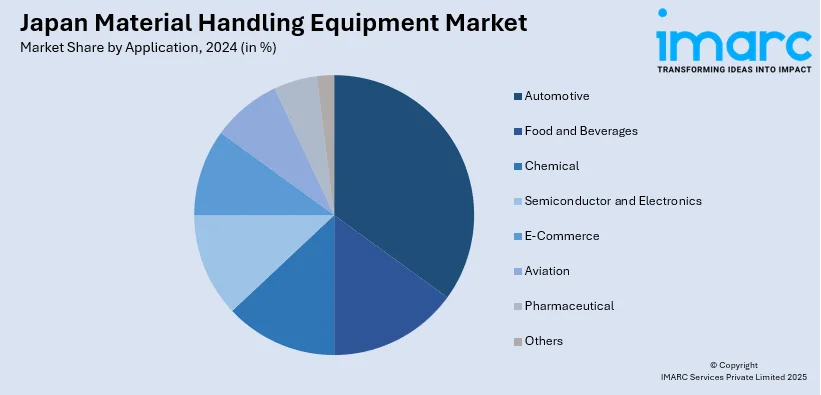
Japan Material Handling Equipment Market Size, Share, Trends and Forecast by Product, Application, and Region, 2025-2033
Japan Material Handling Equipment Market Overview:
The Japan material handling equipment market size reached USD 14.12 Billion in 2024. Looking forward, IMARC Group expects the market to reach USD 27.52 Billion by 2033, exhibiting a growth rate (CAGR) of 6.90% during 2025-2033. Advancements in automation, increasing demand for efficient supply chain management, growth in e-commerce, and a push for safety and labor-saving technologies are some of the factors contributing to Japan material handling equipment market share. The rise in industrial robotics and AI also contributes to market growth.
|
Report Attribute
|
Key Statistics
|
|---|---|
|
Base Year
|
2024 |
|
Forecast Years
|
2025-2033
|
|
Historical Years
|
2019-2024
|
| Market Size in 2024 | USD 14.12 Billion |
| Market Forecast in 2033 | USD 27.52 Billion |
| Market Growth Rate 2025-2033 | 6.90% |
Japan Material Handling Equipment Market Trends:
Automated Safety Enhancement in Logistics
A significant shift is underway in Japanese logistics and manufacturing, centered on leveraging artificial intelligence for operational safety. A new collaborative innovation introduces the nation's premier AI-driven analysis for powered industrial trucks. This groundbreaking service meticulously assesses operator conduct through on-board camera feeds, generating objective safety metrics. Integrated into existing digital operational suites, this technology fundamentally transforms how safety assessments are conducted and how training is delivered. It dramatically reduces the time previously required for manual safety reviews, fostering a heightened sense of safety consciousness among operators. This development promises to elevate safety standards across various facilities, including expansive storage depots and production lines. These factors are intensifying the Japan material handling equipment market growth. For example, in July 2024, Toyota Material Handling Japan (TMHJ) and Fujitsu Limited announced a joint development of Japan’s first AI forklift driving analysis service, aimed at improving safety in material handling equipment operations. This AI-powered service evaluates forklift driving safety by analyzing dash camera footage and automatically generating safety scores. Available via TMHJ's FORKLORE suite, the service streamlines safety evaluations and supports training, reducing review time and enhancing operator safety awareness in material handling environments such as warehouses and factories.

To get more information on this market, Request Sample
Autonomous Loading Revolution
A notable development is reshaping the Japanese material handling landscape: the debut of fully automated truck loading systems employing intelligent, self-operating lift vehicles. A pioneering system, implemented at a major manufacturer's facility, exemplifies this advancement. This initiative marks a crucial stride in the nation's industrial automation journey, demonstrating a profound move towards enhancing logistical effectiveness through hands-free operations. The integrated system streamlines the entire process, from incoming product handling to outbound vehicle loading, establishing a new benchmark for operational advancement. This signifies a rising imperative for clever, integrated solutions within the material handling sector, promising heightened efficiency and reduced manual intervention. For instance, Kao Corporation, in partnership with Toyota Industries, introduced Japan's first fully automated truck loading system using AI-driven forklifts at its Toyohashi Plant. Launched in October 2024, this system is a significant step forward in the Japan material handling equipment market, showcasing a shift toward automation to enhance logistics efficiency. The initiative streamlines operations from product reception to truck loading, setting a new standard for the industry and reflecting the growing demand for smart solutions in material handling.
Japan Material Handling Equipment Market Segmentation:
IMARC Group provides an analysis of the key trends in each segment of the market, along with forecasts at the country and regional levels for 2025-2033. Our report has categorized the market based on product and application.
Product Insights:
- Cranes and Lifting Equipment
- Industrial Trucks
- Continuous Handling Equipment
- Racking and Storage Equipment
The report has provided a detailed breakup and analysis of the market based on the product. This includes cranes and lifting equipment, industrial trucks, continuous handling equipment, and racking and storage equipment.
Application Insights:

- Automotive
- Food and Beverages
- Chemical
- Semiconductor and Electronics
- E-Commerce
- Aviation
- Pharmaceutical
- Others
A detailed breakup and analysis of the market based on the application have also been provided in the report. This includes automotive, food and beverages, chemical, semiconductor and electronics, E-commerce, aviation, pharmaceutical, and others.
Regional Insights:
- Kanto Region
- Kansai/Kinki Region
- Central/Chubu Region
- Kyushu-Okinawa Region
- Tohoku Region
- Chugoku Region
- Hokkaido Region
- Shikoku Region
The report has also provided a comprehensive analysis of all the major regional markets, which include Kanto Region, Kansai/Kinki Region, Central/Chubu Region, Kyushu-Okinawa Region, Tohoku Region, Chugoku Region, Hokkaido Region, and Shikoku Region.
Competitive Landscape:
The market research report has also provided a comprehensive analysis of the competitive landscape. Competitive analysis such as market structure, key player positioning, top winning strategies, competitive dashboard, and company evaluation quadrant has been covered in the report. Also, detailed profiles of all major companies have been provided.
Japan Material Handling Equipment Market News:
- In March 2025, Mitsubishi Heavy Industries Machinery Systems (MHI-MS) developed a domestically produced autonomous vehicle transport robot. The system is designed to move automobiles autonomously and is currently undergoing trial operations and endurance tests. The new model, customized for Japanese specifications, offers enhanced after-sales service and vehicle handling. MHI-MS also provides a "dress-up service" for customized exterior designs, catering to customer preferences in the domestic market.
- In September 2024, Mitsubishi Heavy Industries and Mitsubishi Logisnext showcased cutting-edge autonomous forklift solutions at Logis-Tech Tokyo, underscoring a major development in the material handling equipment industry. The highlights included the ΣSynX automation platform, SynfoX-based unmanned forklifts, and lithium-ion battery models equipped with AI-enabled safety features. These innovations reflect the increasing focus on automation and smart technologies in the market, catering to the rising demand for more efficient, safe, and sustainable material handling solutions in Japan's logistics and warehouse sectors.
Japan Material Handling Equipment Market Report Coverage:
| Report Features | Details |
|---|---|
| Base Year of the Analysis | 2024 |
| Historical Period | 2019-2024 |
| Forecast Period | 2025-2033 |
| Units | Billion USD |
| Scope of the Report |
Exploration of Historical Trends and Market Outlook, Industry Catalysts and Challenges, Segment-Wise Historical and Future Market Assessment:
|
| Products Covered | Cranes and Lifting Equipment, Industrial Trucks, Continuous Handling Equipment, Racking and Storage Equipment |
| Applications Covered | Automotive, Food and Beverages, Chemical, Semiconductors and Electronics, E-Commerce, Aviation, Pharmaceutical, Others |
| Regions Covered | Kanto Region, Kansai/Kinki Region, Central/Chubu Region, Kyushu-Okinawa Region, Tohoku Region, Chugoku Region, Hokkaido Region, Shikoku Region |
| Customization Scope | 10% Free Customization |
| Post-Sale Analyst Support | 10-12 Weeks |
| Delivery Format | PDF and Excel through Email (We can also provide the editable version of the report in PPT/Word format on special request) |
Key Questions Answered in This Report:
- How has the Japan material handling equipment market performed so far and how will it perform in the coming years?
- What is the breakup of the Japan material handling equipment market on the basis of product?
- What is the breakup of the Japan material handling equipment market on the basis of application?
- What is the breakup of the Japan material handling equipment market on the basis of region?
- What are the various stages in the value chain of the Japan material handling equipment market?
- What are the key driving factors and challenges in the Japan material handling equipment market?
- What is the structure of the Japan material handling equipment market and who are the key players?
- What is the degree of competition in the Japan material handling equipment market?
Key Benefits for Stakeholders:
- IMARC’s industry report offers a comprehensive quantitative analysis of various market segments, historical and current market trends, market forecasts, and dynamics of the Japan material handling equipment market from 2019-2033.
- The research report provides the latest information on the market drivers, challenges, and opportunities in the Japan material handling equipment market.
- Porter's five forces analysis assist stakeholders in assessing the impact of new entrants, competitive rivalry, supplier power, buyer power, and the threat of substitution. It helps stakeholders to analyze the level of competition within the Japan material handling equipment industry and its attractiveness.
- Competitive landscape allows stakeholders to understand their competitive environment and provides an insight into the current positions of key players in the market.
Need more help?
- Speak to our experienced analysts for insights on the current market scenarios.
- Include additional segments and countries to customize the report as per your requirement.
- Gain an unparalleled competitive advantage in your domain by understanding how to utilize the report and positively impacting your operations and revenue.
- For further assistance, please connect with our analysts.
 Request Customization
Request Customization
 Speak to an Analyst
Speak to an Analyst
 Request Brochure
Request Brochure
 Inquire Before Buying
Inquire Before Buying




.webp)




.webp)












